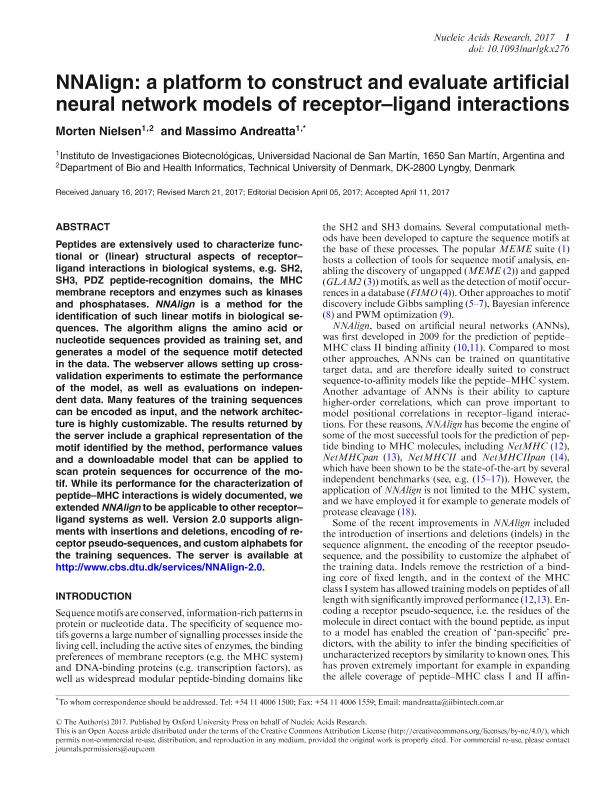Mostrar el registro sencillo del ítem
dc.contributor.author
Nielsen, Morten

dc.contributor.author
Andreatta, Massimo

dc.date.available
2018-06-14T20:24:54Z
dc.date.issued
2017-04
dc.identifier.citation
Nielsen, Morten; Andreatta, Massimo; NNAlign: a platform to construct and evaluate artificial neural network models of receptor–ligand interactions; Oxford University Press; Nucleic Acids Research; 45; 1; 4-2017; 344-349
dc.identifier.issn
0305-1048
dc.identifier.uri
http://hdl.handle.net/11336/48716
dc.description.abstract
Peptides are extensively used to characterize functional or (linear) structural aspects of receptor–ligand interactions in biological systems, e.g. SH2, SH3, PDZ peptide-recognition domains, the MHC membrane receptors and enzymes such as kinases and phosphatases. NNAlign is a method for the identification of such linear motifs in biological sequences. The algorithm aligns the amino acid or nucleotide sequences provided as training set, and generates a model of the sequence motif detected in the data. The webserver allows setting up cross-validation experiments to estimate the performance of the model, as well as evaluations on independent data. Many features of the training sequences can be encoded as input, and the network architecture is highly customizable. The results returned by the server include a graphical representation of the motif identified by the method, performance values and a downloadable model that can be applied to scan protein sequences for occurrence of the motif. While its performance for the characterization of peptide–MHC interactions is widely documented, we extended NNAlign to be applicable to other receptor–ligand systems as well. Version 2.0 supports alignments with insertions and deletions, encoding of receptor pseudo-sequences, and custom alphabets for the training sequences. The server is available at http://www.cbs.dtu.dk/services/NNAlign-2.0.
dc.format
application/pdf
dc.language.iso
eng
dc.publisher
Oxford University Press

dc.rights
info:eu-repo/semantics/openAccess
dc.rights.uri
https://creativecommons.org/licenses/by/2.5/ar/
dc.subject
Receptor-Ligand Interaction
dc.subject
Artificial Neural Network
dc.subject
Sequence Alignment
dc.subject
Machine Learning
dc.subject.classification
Ciencias de la Computación

dc.subject.classification
Ciencias de la Computación e Información

dc.subject.classification
CIENCIAS NATURALES Y EXACTAS

dc.title
NNAlign: a platform to construct and evaluate artificial neural network models of receptor–ligand interactions
dc.type
info:eu-repo/semantics/article
dc.type
info:ar-repo/semantics/artículo
dc.type
info:eu-repo/semantics/publishedVersion
dc.date.updated
2018-06-13T14:16:18Z
dc.identifier.eissn
1362-4962
dc.journal.volume
45
dc.journal.number
1
dc.journal.pagination
344-349
dc.journal.pais
Reino Unido

dc.journal.ciudad
Oxford
dc.description.fil
Fil: Nielsen, Morten. Consejo Nacional de Investigaciones Científicas y Técnicas. Centro Científico Tecnológico Conicet - La Plata. Instituto de Investigaciones Biotecnológicas. Instituto de Investigaciones Biotecnológicas ; Argentina. Technical University of Denmark; Dinamarca
dc.description.fil
Fil: Andreatta, Massimo. Consejo Nacional de Investigaciones Científicas y Técnicas. Centro Científico Tecnológico Conicet - La Plata. Instituto de Investigaciones Biotecnológicas. Instituto de Investigaciones Biotecnológicas ; Argentina
dc.journal.title
Nucleic Acids Research

dc.relation.alternativeid
info:eu-repo/semantics/altIdentifier/url/https://academic.oup.com/nar/article/45/W1/W344/3605642
dc.relation.alternativeid
info:eu-repo/semantics/altIdentifier/doi/http://dx.doi.org/10.1093/nar/gkx276
Archivos asociados
